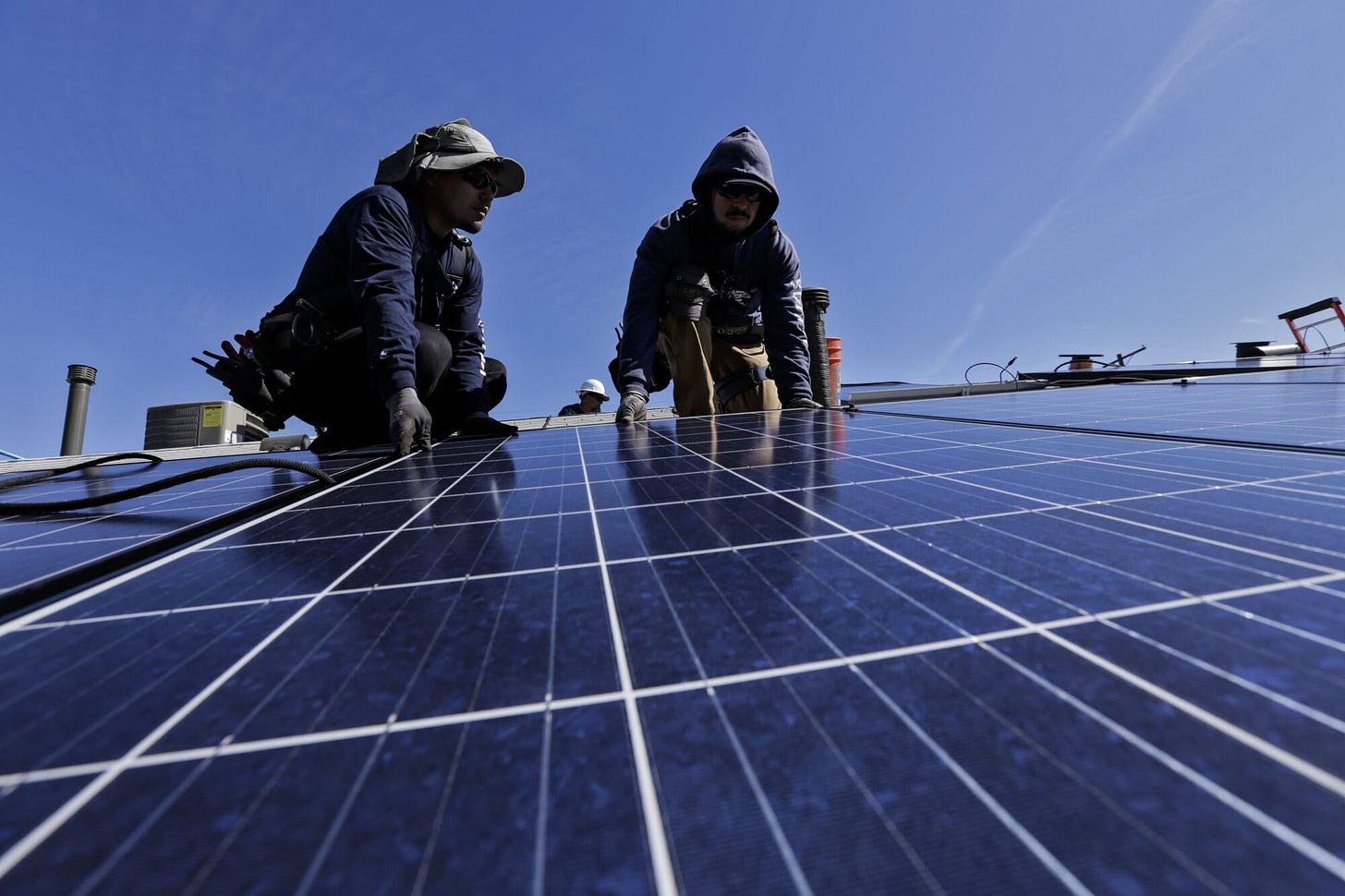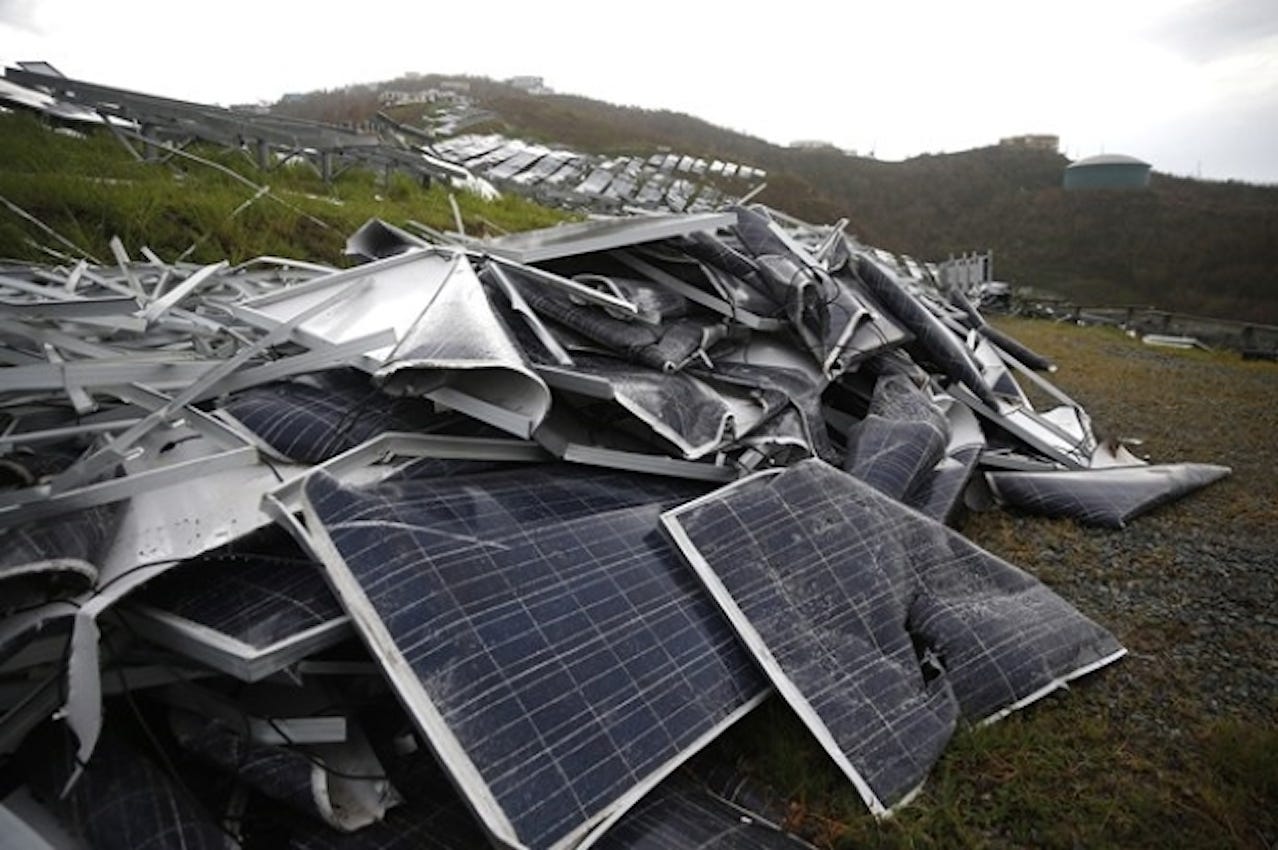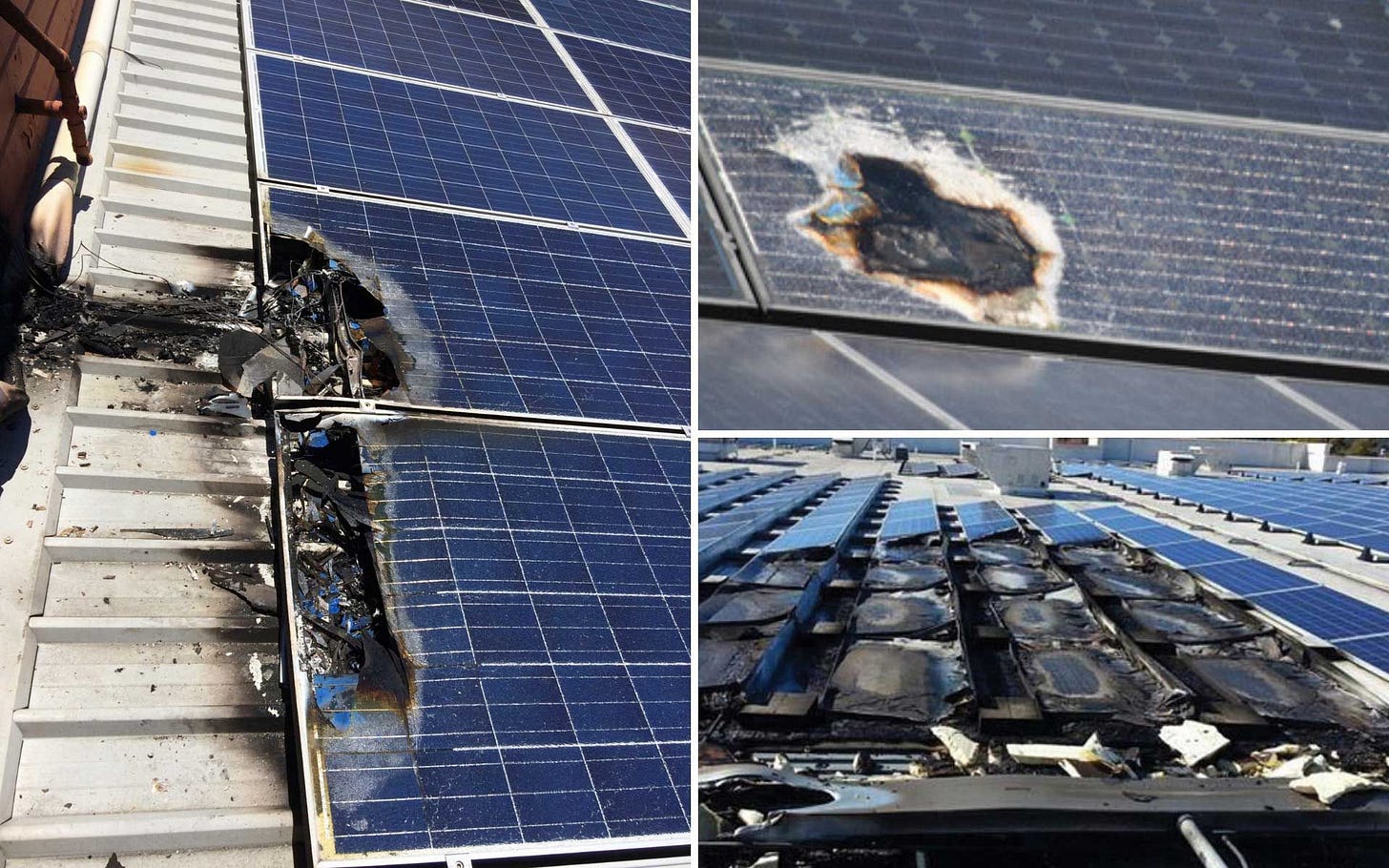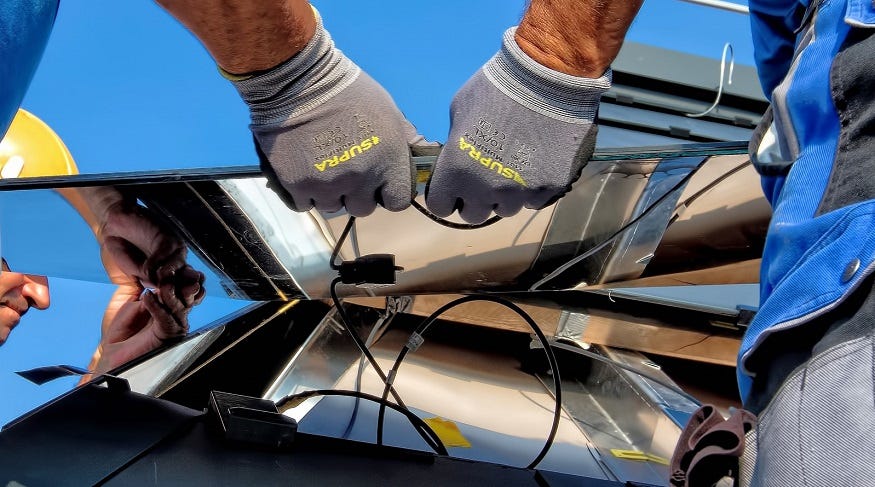An Avalanche of Solar Panels is Coming to a Dump Near You
Solar panels compete with wind turbine blades for landfill space
Tuco's Child Preface
We are facing an avalanche of solar panel waste. This is because typical solar panel in-service lifetime is shorter than the advertised theoretical 20-30 years, and taxpayer subsidized propagation of solar panels has greatly increased over the last 15 years.
In one important trend, people are replacing solar panels early to take advantage of next generation technology and receive taxpayer incentives to do so. Another common but less discussed reason for early panel replacement is damage from hail and other debris.
Picture of hail damaged panels above
In one example of hail damage, JF, who is involved in common sense opposition to solar and wind power in Texas has shared that in Midway, hail storms have damaged 400,000 + panels just a few years ago; and no one can answer the question of what happened to them, except for the insurance companies who stood up and paid attention as it cost them dearly.
TX is also unfortunately in the spotlight regarding the pending avalanche of waste, as JF further reports that the present interconnection list on ERCOT projects 500 million installed solar panels in Texas in the next 10-15 years, which does not include rooftop, or already installed operating capacity.
Solar panels and ancillary parts also fail, especially those from Chinese companies that have flooded the market with inferior quality products. Short circuits and failures happen, which can lead to an entire home burning to the ground, similiar to EVs in a garage or on a container ship.
Unfortunately, there are no financial or practical reasons to recycle a solar panel. This is because sending it to a landfill costs on the order of $1-$2 per panel, in contrast to an estimated $20-$30 to recycle.
The lack of recyclability hinges on the fact that while panels do contain a number of useful and valuable chemical elements, they exist in minute amounts, as the bulk and mass of a panel is mostly relatively low-value glass with aluminum framing. Further, panels are sealed to prevent moisture and oxygen ingress and comprise multi-layer structures, so they are expensive to “dismantle” and extract value from the dilute chemical elements within. Specialized equipment and workers are also needed to dismantle a panel and separate the aluminum frame and junction box from the panel without shattering it into glass shards. Specialized furnaces are used to heat panels to recover silicon, which requires burning fossil fuels in a reducing environment.
Hazardous waste: even though toxic elements such as Pb, Cd, Te, and Se in a panel are in very low concentrations, solar panels are classified as hazardous materials in many states, and thus require expensive restrictions on packaging, transport and storage.
In one example, high efficiency USA built First Solar (FSLR) thin film solar panels contain highly toxic cadmium and tellurium, therefore FSLR panels are deemed to be hazardous waste in most states. Because of this, FSLR is forced to recycle these panels to protect the environment and people’s health and protect themselves from a great deal of liability.
The vast majority of residential solar arrays in the U.S. are crystalline silicon panels, which can contain lead, although it’s less prevalent in newer panels.
Below is a cartoon showing the chemical elements in a panel, most very dilute and hard to extract in any practical way:
Boom in Solar Panel Waste Due to Taxpayer Incentives
U.S. home installations of solar panels have rebounded from the Covid slump, with analysts predicting more than 19 gigawatts of total capacity installed, compared to 13 gigawatts at the close of 2019. Over the next 10 years, that number may quadruple, according to industry research data. And that’s not even taking into consideration the further impact of possible new regulations and incentives launched by the “green-friendly” Biden administration.
Solar’s pandemic-proof performance is due in large part to the Solar Investment Tax Credit, which defrays 26% of solar-related expenses for all residential and commercial customers (just down from 30% during 2006–2019). After 2023, the tax credit will step down to a permanent 10% for commercial installers and will disappear entirely for home buyers. Therefore, sales of solar will probably burn even hotter in the coming months, as buyers race to cash in while they still can.
Tax subsidies are not the only reason for the solar explosion. The conversion efficiency of panels has improved by as much as 0.5% each year for the last 10 years, even as production costs (and thus prices) have sharply declined, thanks to several waves of manufacturing innovation mostly driven by industry-dominant Chinese panel producers. For the end consumer, this amounts to far lower up-front costs per kilowatt of energy generated.
Deceptive Data: People Ditch Panels Early to Upgrade.
Economic incentives encourage customers to trade their existing panels for newer, cheaper, more efficient models.
The International Renewable Energy Agency (IRENA)’s official projections assert that “large amounts of annual waste are anticipated by the early 2030s” and could total 78 million tonnes by the year 2050. That’s a staggering amount, undoubtedly. But with so many years to prepare, it describes a billion-dollar opportunity for recapture of valuable materials rather than a dire threat. The threat is hidden by the fact that IRENA’s predictions are premised upon customers keeping their panels in place for the entirety of their 30-year life cycle. They do not account for the possibility of widespread early replacement.
If early replacements occur as predicted by our statistical model, they can produce 50 times more waste in just four years than IRENA anticipates. That figure translates to around 315,000 metric tonnes of waste, based on an estimate of 90 tonnes per MW weight-to-power ratio.
Alarming as they are, these stats may not do full justice to the crisis, as our analysis is restricted to residential installations. With commercial and industrial panels added to the picture, the scale of replacements could be much, much larger.
The High Cost of Solar Trash
The industry’s current circular capacity is woefully unprepared for the deluge of waste that is likely to come. The financial incentive to invest in recycling has never been very strong in solar. While panels contain small amounts of valuable materials such as silver, they are mostly made of glass, an extremely low-value material. The long life span of solar panels also serves to disincentivize innovation in this area.
As a result, solar’s production boom has left its recycling infrastructure in the dust. To give you some indication, First Solar is the sole U.S. panel manufacturer we know of with an up-and-running recycling initiative, which only applies to the company’s own products at a global capacity of two million panels per year. With the current capacity, it costs an estimated $20–$30 to recycle one panel. Sending that same panel to a landfill would cost a mere $1–$2.
The direct cost of recycling is only part of the end-of-life burden, however. Panels are delicate, bulky pieces of equipment usually installed on rooftops in the residential context. Specialized labor is required to detach and remove them, lest they shatter to smithereens before they make it onto the truck. In addition, some governments may classify solar panels as hazardous waste, due to the small amounts of heavy metals (cadmium, lead, etc.) they contain. This classification carries with it a string of expensive restrictions — hazardous waste can only be transported at designated times and via select routes, etc.
The totality of these unforeseen costs could crush industry competitiveness. If we plot future installations according to a logistic growth curve capped at 700 GW by 2050 (NREL’s estimated ceiling for the U.S. residential market) alongside the early-replacement curve, we see the volume of waste surpassing that of new installations by the year 2031. By 2035, discarded panels would outweigh new units sold by 2.56 times. In turn, this would catapult the LCOE (levelized cost of energy, a measure of the overall cost of an energy-producing asset over its lifetime) to four times the current projection. The economics of solar — so bright-seeming from the vantage point of 2021 — would darken quickly as the industry sinks under the weight of its own trash.
Who Pays the Bill?
It will almost certainly fall to regulators to decide who will bear the cleanup costs. As waste from the first wave of early replacements piles up in the next few years, the U.S. government — starting with the states, but surely escalating to the federal level — will introduce solar panel recycling legislation. Conceivably, future regulations in the U.S. will follow the model of the European Union’s WEEE Directive, a legal framework for the recycling and disposal of electronic waste throughout EU member states. The U.S. states that have enacted electronics-recycling legislation have mostly cleaved to the WEEE model. (The Directive was amended in 2014 to include solar panels.) In the EU, recycling responsibilities for past (historic) waste have been apportioned to manufacturers based on current market share.
A first step to forestalling disaster may be for solar panel producers to start lobbying for similar legislation in the United States immediately, instead of waiting for solar panels to start clogging landfills. In our experience drafting and implementing the revision of the original WEEE Directive in the late 2000s, we found one of the biggest challenges in those early years was assigning responsibility for the vast amount of accumulated waste generated by companies no longer in the electronics business (so-called orphan waste).
In the case of solar, the problem is made even thornier by new rules out of Beijing that shave subsidies for solar panel producers while increasing mandatory competitive bidding for new solar projects. In an industry dominated by Chinese players, this ramps up the uncertainty factor. With reduced support from the central government, it’s possible that some Chinese producers may fall out of the market. One of the reasons to push legislation now rather than later is to ensure that the responsibility for recycling the imminent first wave of waste is shared fairly by makers of the equipment concerned. If legislation comes too late, the remaining players may be forced to deal with the expensive mess that erstwhile Chinese producers left behind.
From the “Green” LA Times, a surprising critique:
California has been a pioneer in pushing for rooftop solar power, building up the largest solar market in the U.S. More than 20 years and 1.3 million rooftops later, the bill is coming due.
Beginning in 2006, the state, focused on how to incentivize people to take up solar power, showered subsidies on homeowners who installed photovoltaic panels but had no comprehensive plan to dispose of them. Now, panels purchased under those programs are nearing the end of their typical 25-to-30-year life cycle.
Many are already winding up in landfills, where in some cases, they could potentially contaminate groundwater with toxic heavy metals such as lead, selenium and cadmium.
Sam Vanderhoof, a solar industry expert and chief executive of Recycle PV Solar, says that only 1 in 10 panels are actually recycled, according to estimates drawn from International Renewable Energy Agency data on decommissioned panels and from industry leaders.
The looming challenge over how to handle truckloads of waste, some of it contaminated, illustrates how cutting-edge environmental policy can create unforeseen problems down the road.
“The industry is supposed to be green,” Vanderhoof said. “But in reality, it’s all about the money.”
California came early to solar power. Small governmental rebates did little to bring down the price of solar panels or to encourage their adoption until 2006, when the California Public Utilities Commission formed the California Solar Initiative. That granted $3.3 billion in subsidies for installing solar panels on rooftops.
Orben said the economics of the process don’t make a compelling case for recycling.
At best, only about $2 to $4 worth of materials are recovered from each panel. The majority of processing costs are tied to labor, and Orben said even recycling panels at scale would not be more economical.
Most research on photovoltaic panels is focused on recovering solar-grade silicon to make recycling economically viable.
That skews the economic incentives against recycling. The National Renewable Energy Laboratory estimated that it costs roughly $20 to $30 to recycle a panel versus $1 to $2 to send it to a landfill.
The California Department of Toxic Substances collected its first data on panels recycled by universal waste handlers in 2021. For handlers that accepted more than 200 pounds or generated more than 10,000 pounds of panels, the DTSC counted 335 panels accepted for recycling, said Sanford Nax, a spokesman for the agency.
The department expects the number of installed solar panels in the next decade to exceed hundreds of millions in California alone, and that recycling will become even more crucial as cheaper panels with shorter life spans become more popular.
A lack of consumer awareness about the toxicity of materials in some panels and how to dispose of them is part of the problem, experts said.
“There’s an informational gap, there’s a technological gap, and there’s a financial gap that we’re working on,” said Amanda Bybee, co-founder of SolarRecycle.org, a website aimed at helping people understand how to recycle solar panels and how the process works.
Last year, new DTSC regulation came into effect that reclassified the panels, changing the way they can be collected and transported. Previously, all panels were required to be treated as hazardous waste upon removal, which restricted transportation and storage.
Both business and residential consumers, or generators as they are called in the recycling industry, were supposed to transport the panels themselves to certified recycling or hazardous waste disposal facilities. With little tracking, it’s unclear how frequently that occurred.

Now, panels are classified as universal waste and can be collected at more than 400 universal waste handlers in California, where they are then assessed and transported to disposal, reuse or recycle facilities. (In cases where panels containing toxic materials are relegated to landfills, they are sent to facilities with extra safeguards against leakage.) The new regulations were intended to make it easier for people to turn in their panels, but it does not directly address the next step — recycling.
“What that [rule] does is really just changes how that material is handled, managed, stored, and transported,” said Orben of We Recycle Solar. “It doesn’t change how that material is actually processed.”
In 2016, the Solar Energy Industries Assn., a nonprofit trade association for the U.S. solar industry, started a recycling program for panels. Robert Nicholson, the manager of PV Recycling at the association, said it aims to help the industry group’s recycling partners — five so far — “develop compliant, cost-effective recycling services for end-of-life modules.”
“The majority of recyclers are already existing recyclers; they’re primarily doing e-waste or they’re doing glass,” said Evelyn Butler, the association‘s vice president of technical services. “So we have had to work with them to kind of take that leap, to say: ‘We believe that the processes you’re using can accommodate the technology.’” The association also works with regulators to draft legislation that decreases the number of panels heading to landfills.
Government subsidies are one way to make solar panel recycling economically viable for the waste generators, who now bear much of the cost of recycling.
In Europe, a recently enacted regulation called the European Union Waste of Electrical and Electronic Equipment Directive places responsibility on producers for supporting their products through responsible end-of-life disposal. It requires all producers that manufacture panels for countries in the EU to finance end-of-life collection and recycling.
Similar legislation has been attempted in several U.S. states, including Washington, where the Photovoltaic Module Stewardship and Takeback Program will require solar panel manufacturers to finance end-of-life recycling. The initiative was passed in 2017 and will begin implementation in 2025. It’s the only producer-responsibility law in the United States.
It’s part of a larger strategy in the recycling industry called extended producer responsibility, in which the cost of recycling is built into the cost of a product at its initial purchase. Business entities in the product chain — rather than the general public — become responsible for end-of-life costs, including recycling costs.
In a 2020 interview with PV Magazine, Jigar Shah, co-founder of Generate Capital, a fund that invests in sustainable infrastructure, said the problem can be addressed at the very start of the product chain — by manufacturers. Shah, who is now director of the Department of Energy’s Loan Programs Office, said that policymakers need to require manufacturers to come up with a standard design that makes panels easier and cheaper to recycle.
“It’s far more cost-effective for manufacturers to be forced to work together … where they try to greatly reduce the cost of all that collectively. That happens through policy,” he said. “It doesn’t happen through people opting in.”

(Jim Cooke / Los Angeles Times)
In April 2022, Santa Monica concluded a solar panel recycling pilot program in partnership with the California Product Stewardship Council, a public-private partnership. The stewardship council surveyed local residential solar owners and found that many, at a loss for what to do with end-of-life panels, called up installers for help.
“We did find that the solar installers were the best contact for us to learn about how many decommissioned panels were in our region,” said Drew Johnstone, a sustainability analyst for Santa Monica. “Some contractors did end up just having to pile them in their warehouses, because there’s no good solution for where to bring them.”
Johnstone says the universal waste reclassification has made a big difference, cutting down on cost and paperwork needed for handling modules, and more handlers can accept the panels from generators.
“It’s going to be a really large issue in a number of years,” Johnstone said. “So it would behoove local governments, county, state, and it can go federal too, to have a plan in place for all these panels that will reach their end of life in 10 to 15 years.”
From PV Magazine
Solar trash: without intervention, a shocking (and costly) amount will be produced
With deployments of solar on a steady rise, a plan is needed for the end of life of solar panels, or the world could see at least 78 million tons of waste by 2050, said IRENA.
From PV Magazine RYAN KENNEDY
The growth of solar will be instrumental in the world’s fight against emission-caused climate change, but not all is rosy for the technology.
Without changes to the current structure of solar panel retirements, the world could witness some 78 million tons of solar trash disposed in landfills and other waste facilities by 2050, according to the International Renewable Energy Agency (IRENA). They predict the U.S. will contribute 10 million metric tons of trash to that 2050 total.
To put into context, the U.S. dumps almost 140 million tons of waste each year, according to the Environmental Protection Agency. So while solar waste may seem like a drop in the bucket, researchers writing in the Harvard Business Review (HBR) are growing concerned that the wave of solar trash may be much larger, and on a much closer horizon than originally predicted.
According to the HBR article, the IRENA estimates may be conservative as they assume a 30-year life for panels before retirement, a timeframe that the HBR authors viewed as probably unrealistic. They said that early replacement of solar panels will likely increase as incentives offered to consumers shift.
If the cost of trading up for new, more efficient, highly incentivized solar panels is low enough, and if the grid compensation rate is high enough, then the HBR authors said they expected consumers to swap out for new panels, regardless of whether or not their current equipment has more years of productive life.
With this factored in, the HBR projection makes solar waste a much more immediate problem. Projections land at 50 times the IRENA outlook for the next five years. And this analysis only factors in residential-side conditions; shifting incentives at the commercial and utility scale could drive still more early retirements.
The National Renewable Energy Laboratory (NREL) estimates that the U.S. ceiling for solar deployment is around 700 GW by 2050. The HBR study’s early replacement projection showed that the volume of waste could actually surpass that of new installations by 2031. Around four years later, panel trash could outweigh new modules sold by more than two-and-a-half times.
Cost problems mounting
To make matters more difficult, some governments classify solar panels as hazardous waste, largely due to a small amount of cadmium and lead. This increases transport costs, requiring longer trucking miles, specialized vehicles and specialized processing centers. Add to this the fact that it requires labor to remove these panels from roofs, fields, and carports, and equipment end-of-life costs increase.
This would have a thunderous impact on the levelized cost of energy (LCOE) of solar, increasing it to four times the current projection, said the HBR authors.
And as for solutions?
Clearly, solar panel recycling capacity must be built, with a holistic end-of-life infrastructure including removal, transport, and even temporary waste storage.
The HBR authors suggested that government intervention will be needed to incentivize recycling. Evolution on this front is occurring in Europe, where PV panel producers are now liable for the end-of-life phase of a panel, and for financing waste management, said the IRENA report.
“Orphaned-waste” programs will also be needed to find a path for panels deployed by companies no longer in business, said the HBR authors.
IRENA suggested the EU-passed WEEE Directive, an electronics recycling regulation, could serve as a waypoint for U.S. legislation. The EU added solar panels to their electronics waste regulations in 2014. But the U.S. has not yet added solar panels to the “e-waste” classification as an amendment to the Resource Conservation and Recovery Act.
The UN reports that only 17.4% of global e-waste in 2019 was collected and recycled, even though 71% of the world’s population, in 78 countries, is covered by some type of legislation or policy on recycling. Only one major U.S. panel manufacturer, First Solar, has enacted an in-house recycling program, said HBR.
Complexities
NREL reported that the current regulatory scheme for managing end of life (EoL) PV modules is complex and varies by jurisdiction, and there is not a clear understanding of the permitting requirements or liabilities associated with the full cycle of EoL processing. To date, the most common regulatory mechanisms for EoL product management are extended producer responsibility (EPR) and landfill diversion policies. However, no publicly available study comprehensively analyzes the overall success of these policies, or how they compare to other regulatory models, or whether these frameworks make sense for PV modules, said NREL.
IRENA said with the right policies and enabling frameworks in place, new industries can be spawned to repurpose and recycle old solar PV panels, driving considerable economic value creation. NREL supports this notion, and said that more information is needed to support value creation.
Specifically, they identify a need for more information about the value of and the markets for recovered materials, the volume and composition of EoL PV modules, module recycling technology and infrastructure needs, permitting requirements and liabilities, and costs associated with PV module recycling.
NREL said that decreasing uncertainty will pave the way towards a more appropriate response to this issue.
For example, using mandates or incentives so that manufacturers provide PV module labels with concentrations of hazardous material could provide transparency between stakeholders and eliminate the need for expensive hazardous waste testing.
In general, the NREL report advocated for policies that reduce the regulatory burden for recycling compared to disposal, thereby making the economics of recycling more palatable to decision-makers.















Great article - indeed lots of meat.
This issue is so far from new but somehow seems to get pushed under the rug constantly! Glad you are bringing it up.
The renewables industry has evaded the question (NREL) with just a few studies and nothing that you could take to the bank. Still the investors only see the up front money and never the end game - which leads you to believe the solar companies will not want to address it either.
I'm not much of an optimist on their behavior as you are. Been in the trenches with them too long. With the interconnection list on ERCOT at present there will be over 500 Million solar panels in Texas alone in the next 10-15 years. (I don't like the tons figures - because I just can't picture what a ton of solar panels looks like - but I can picture 1/2 Billion of them!) This does not include rooftop, or already installed operating capacity. We have had numerous hail storms damage panels - 400,000 alone in Midway a few years ago - but no one can answer the question of what happened to them. TCEQ was never notified, and I sure there was leaching. The insurance companies are the only ones who stood up and paid attention! Cost them!
Like you I'd love to think they could be recycled , but look what happened to the wind turbines, and the recycle facilities have not been up to the task. The renewable industry doesn't make enough money without subsidies so they won't be the responsible adults in the room.
You made some very good points and the industry is running away from this issue and I think no matter how we legislate it will still not make a difference. The government and the industry is in a "get it in at what ever cost and get it done" mode and all the screaming about climate change is their excuse to make a buck and run!
Solar graveyards all across Texas - the counties will end up owning a lot of them! Solar corporations will sue the counties for the tax bills (already happening) they don't want to pay and then it will end up falling on the land owner, when they can't pay the tax bills either, then it will fall on the county when they have to repossess them for none payment. Most don't see that coming. So back to the taxpayer....
I'm sure there may be some good actors in the solar industry - but I haven't see that or any of my friends across the state who are dealing with them.
Thank for you article - I have shared it on my facebook page https://www.facebook.com/groups/erathcountystopsolarfarmshere
Thank you for reporting. Will not see this story on con or msnbc anytime soon. Government subsidies, crony capitalism. Socialists throwing the free market system right down the crapper.
Another example in today's news feed of government run amok with DIRTY green energy.
https://www.foxnews.com/politics/new-report-unmasks-true-costs-electric-vehicle-mandates-remain-expensive